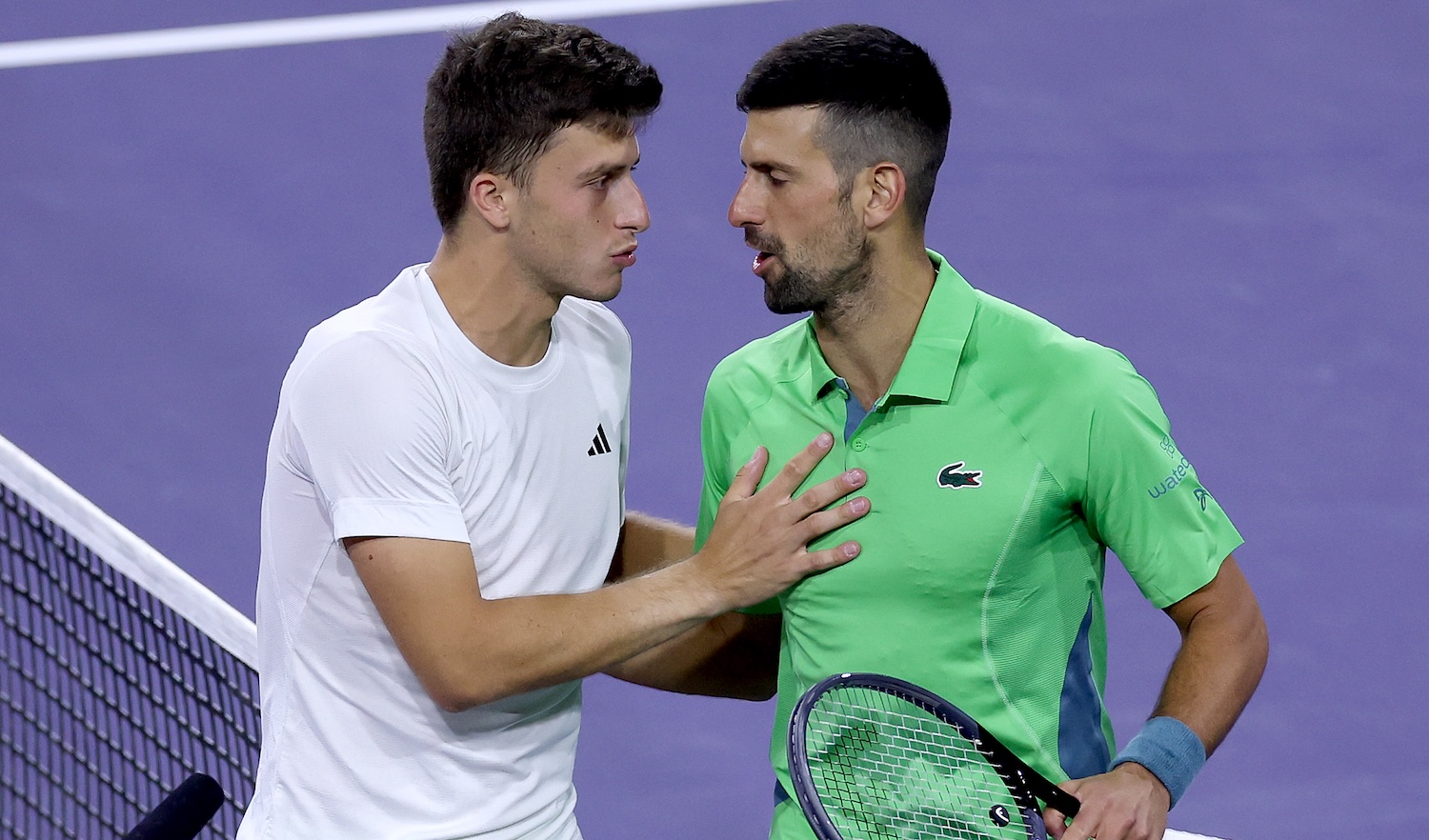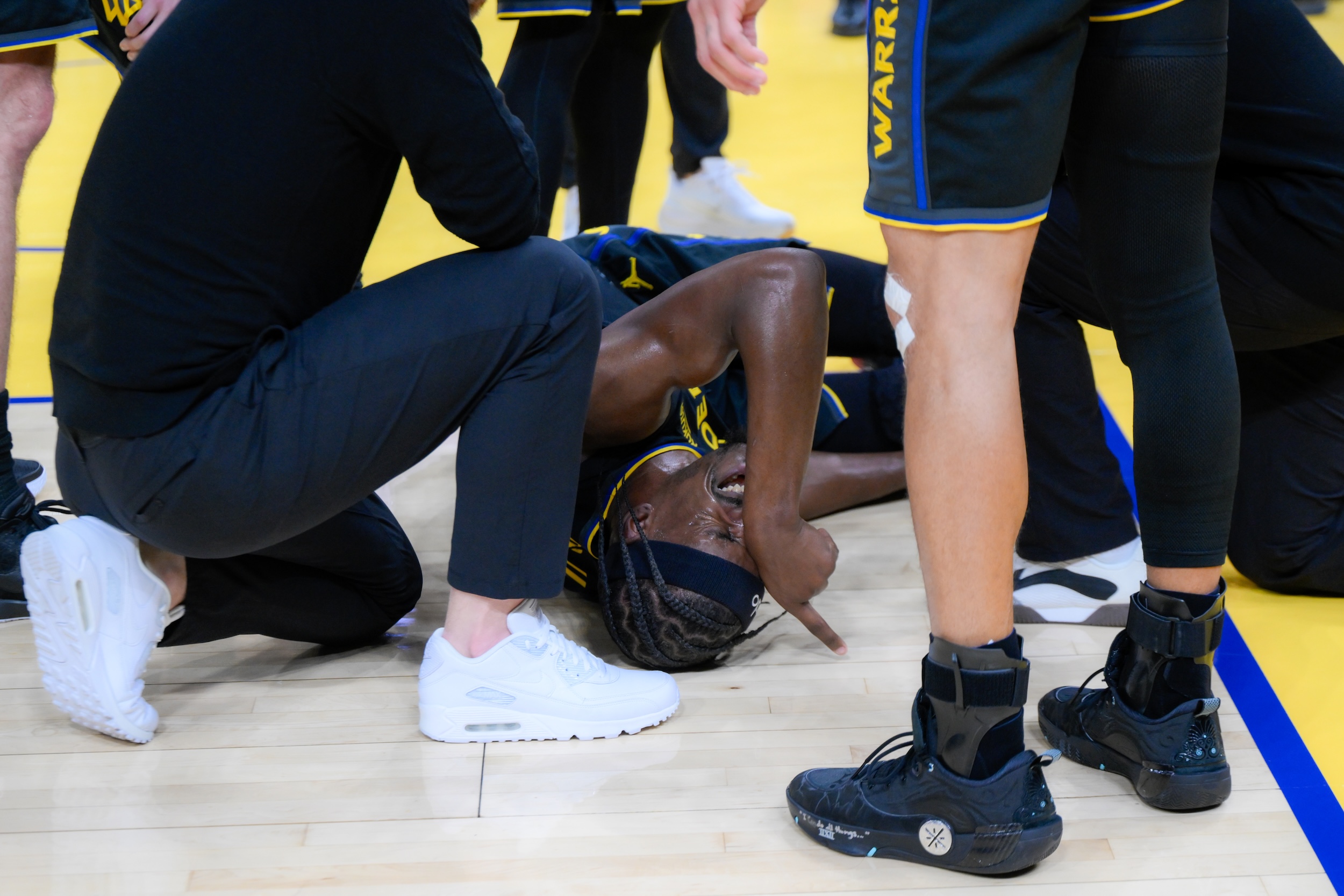The action at Indian Wells, one of the season's biggest tournaments in men's and women's tennis, is well underway. Defector tennis bureau chief Giri Nathan and correspondent Patrick Redford arrived on the grounds on Monday to assess the third-round drama, discuss Patrick's first impressions of a tournament of this size, consider the comedic mastermind of Daniil Medvedev, examine Naomi Osaka's shaky comeback, and more.
Giri Nathan: Patrick, congrats on attending your second tennis tournament, after the Berkeley W60. As you might have noticed, Indian Wells is operating at a slightly different scale. For one, I don’t think there’s a Saudi PIF tent at the Berkeley W60, but we’ll get to that later. What are you noticing as you watch some of the best players in the world up close in the desert?
Patrick Redford: If the Saudis take notice of a tournament where the 221st-ranked player won in front of two dozen people down the street from Amy Chua’s house, we might have to hand it (sports) to them forever, but Indian Wells is on a totally different scale and I’m having a blast and trying to unfocus my eyes and watch from as many different angles as I can. Let’s look only at Novak Djokovic’s coach on this one point; I will only watch Sebastian Baez’s feet for a few points; it’s time to mostly listen to whose racket makes twangier booms; et cetera. After the first few matches—Baez shuffled those feeties but there’s only so much you can do against a guy nine inches taller than you—I was worried this would be all we’d get from the first day, but no, we saw who had the twangiest booms in all of Southern California: Luca Nardi.
GN: Yeah, we gotta start with the biggest news from the third round: an exhilarating three-set upset of No. 1 seed Novak Djokovic at the hands of 20-year-old Luca Nardi, who is ranked No. 123 in the world. I knew Nardi was a great prospect but this was the first chance I had to see him in person. He was a lucky loser—that means he lost in the qualifying rounds, but lucked into a spot in the main draw when another player pulled out of the tournament. In this case, Nardi filled the slot of a seeded player, so he extra-lucked into a first-round bye, and pulled off a nice win in round two, but was relatively untested before running smack into Djokovic. We showed up early in the second set once we saw Nardi had managed to grab the first set on Novak. What impressed you about his play in this match, and what was it like to see Novak for the first time, if admittedly not on his A-game?
PR: The experience of watching Djokovic when he’s behind at any point in any match is a Damoclean one of waiting for him to start breaking it down, and in that second set, it seemed that he was about to dispatch Nardi with ease. The Italian’s serve tightened up, he stopped getting creative, and he generally ceded the initiative while Djokovic was piecing him up. So for Nardi to hit the third set and win it, not so much by waiting for Djokovic to duff it into the net—which to be fair he did a fair bit of—but by pushing him back and hitting some truly pure shots into audacious zones, was so impressive. That was his only win condition.
Any hotshot prospect can hit some big-time winners and slap that forehand around, but what’s so great about tennis is that the barrier between hitting some nice shots and winning is formidable, and it takes something more than pure ball-striking to actually pull off an upset like this. Djokovic would noticeably dial up the intensity in the biggest moments, like in the two five-deuce service games he had, and Nardi had to raise his level to stay with him as a roaring stadium of fans ratcheted up the tension. That takes mental and emotional strength, the sort you wouldn’t associate with a 20-year-old, and Nardi was more than willing to wrong-foot Djokovic with a serve-and-volley here, a ridiculous backhand there, despite the frothing crowd and the leering presence of Bill Gates. He had to be brave, and he was.
GN: Though we saw the nerves hit once he was up a break in the third set, with some tight serving at the 4-2 game, I was impressed by how doggedly Nardi kept at his offensive tennis in the final stretch of the match—he finished his second-to-last point with a tricky swinging volley—and yes, it’s a testament to the fact you can’t run out the clock in tennis. Nardi has more game than I realized, brilliant groundstrokes and soft hands, and he was bullying Djokovic around the court, pushing him back behind the baseline whenever he wanted. It’s rare to ever see Djokovic in a position to be bullied; he’s typically the one perched comfortably on top of the baseline and directing traffic to the corners, and while he credited Nardi’s good play, he said afterward that “my level was really, really bad.” He was leaking uncharacteristic unforced errors and there wasn’t a lot of weight on his shots. It’s unusual for Djokovic to not have a title at this point of the season. I don’t think he’s necessarily lost a step, but it’s a flat start to the year.
PR: Those guys who sat right in front of us with that huge Serbian flag in the third set probably thought they’d see their boy win.
GN: I think Djokovic won one game for the rest of the match. Not the outcome they were looking for. You got a pretty precious in-person fan experience, though: the chills of seeing a young underdog beat the GOAT and act out his own disbelief.
PR: The crowd, while pro-Novak, really got behind Luca. You see this on broadcasts, but the way the noise slows, tapers down, then hits full silence for a quarter-second before the serve before resuming at a low murmur is a pleasant sensation. They don’t always have to be told Europeanly “... please …” but it helps.
GN: I noticed that Bill Gates was allowed to move around and walk to his seat, in the fancy box right behind the baseline, in between points during a game, and nobody really yelled at him.
PR: My personal favorite fan of the day was the lady waving a Brazil flag between games at Nardi–Djokovic; my second was Faye Webster watching the Naomi Osaka loss; third favorite was the Medvedev lady. Can you explain her deal?
GN: Daniil Medvedev tied his shoe between points late in his match. A lady in the stands yelled “Tie those shoes, Daniil! Bend over!” A few minutes later she shouted out “Handsy!” in the middle of a long rally. After the rally Medvedev said “Shut up, piece of shit,” in her general direction. A fan on the other side of the arena added “Shut up, Karen.”
PR: As a fan of both comedy and the limits of the human body, Medvedev was my single favorite player to watch. He won a tense three-setter against Sebastian Korda in the evening session, a match that contained both the longest rally and the best bits we saw all day. What did you see in Korda–Medvedev?
GN: When you get up close, you can see all the tiny moments of Medvedev comedy that would be lost on broadcast. Like this one: Korda, frustrated after losing his serve in the third set, walks over to his chair, and bangs his racquet against the sponsor sign on the net before sitting down. Medvedev approaches the same sign from the opposite direction just seconds later. He bangs the sign, too. Why? He was winning. Just the pure unteachable instincts of a troll. Last year, he was bickering with the court surface here. Any little spark will do.
In general, it’s always fun to see Medvedev’s ball-striking up close. I think it’s one of the great feasts of hand-eye coordination in all of sports. His pancake-flat shots stay so close to the court after the bounce, and he places it with such ungodly accuracy, with such low margin over the net. And half the time he looks like he’s wrapping his arms around his own neck with his patented octopus follow-throughs. Korda, meanwhile, has some of the most classically refined technique on all his shots and was playing especially clean in this one; I don’t think these guys hit an unforced error in the third set, even as they went break for break. I’m still thinking about those points where Medvedev would hit exactly the same annoyingly flat and deep forehand cross five or six times in a row, daring Korda to break the pattern with a riskier shot. Also, it’s still bizarre to see a guy that large and lanky sprinting up from the back wall of the court to scoop up drop shots. Between the wingspan and the foot speed, the Medvedev court coverage is baffling.
PR: Medvedev really is unlike anyone else we watched yesterday. He has optical-illusion body; he seems impossibly curved. He’s so tall and lanky, he seems to hold his shoulders quite high, he has those looping, elegant strokes, and he covers the whole court. That last bit had Korda frustrated, though he was hitting well enough to get Medvedev frustrated, and the 16 breaks of serve speak as much to the quality of both players’ return games as to the mental resilience they each had to keep trying to break their opponent after yeeting it into the net. It was a marked contrast to the pyrotechnics of Luca Nardi, and it was such a Medvedev-ass match. What are you supposed to do against a guy who can sprint to every ball and even when he gets pissed off can rely on a deep well of Gamer Mindset–style self-control tactics to slow down his heartbeat?
GN: You have to be either a pervert or an ultra-connoisseur (or both) to call Medvedev “elegant,” so I salute you. Those were the most thrilling matches we saw, but what did you think of the strangely low-energy Naomi Osaka loss to Elise Mertens? An almost empty stadium for one of the most famous tennis players in the world. You also got a look at how disjointed tennis can look when a hyper-aggressive player is off her game.
PR: That was a real bummer. I’d hoped to see Osaka make something of her match but mostly she hit huge booming forehands 15 feet behind the baseline. Those eye-popping misses—again, in front of what was probably 2,000 fans but felt like 200—came in between some flashes of brilliance, and a lesson I learned from that match was that for a power-hitter, the margins between totally dominating a match and getting totally dominated are very fine. It didn’t matter that Osaka could hit Mertens off the court every fifth point; she could barely return it the other four.
GN: Osaka was missing shots by margins you rarely see in the pro game: baseline shots going 15 feet out. When you play as big as Osaka does, tiny misjudgments of racquet face-angle have devastating consequences, and it’s easier to appreciate cause and effect from up close. Even in her incredible prime, she really only liked to play this one way, so there isn’t much of a backup plan when her power is failing her. Some days she finds no rhythm, and that’s it. This might make her comeback a little slower and rockier than it would be for a player with more options to cycle through. Once Mertens realized Osaka was off her game that day, she dialed down the intensity on all her own swings and relied on sweet defensive chops, tracking every ball down and redirecting her opponent’s power back into the court, awaiting the inevitable error.
PR: It was deflating to watch someone win with such an anti-tennis gameplan, and that underscores the brutal competitiveness that I’m coming to appreciate about the sport the more time I spend around it. I got hooked by the aesthetic highs, though it’s not always like that: Sometimes the way to win is to turtle up and dare your opponent to play tennis at you. The thing that matters is not how you win your points but how many points you win. At least we got a refreshing all-power palate cleanser shortly afterward when we saw Maria Sakkari and Caroline Garcia have a strength-measuring contest. Sakkari’s little disguised forehand winner in the second set was so pure.
GN: Garcia is committed to the Osakaesque lifestyle, perhaps to an even greater degree, in the sense that she is going big on every single ball that comes her way. That can lead to some electrifying matches and also some arrhythmic duds. We caught this match right as it was turning the corner from the former into the latter. That Sakkari inside-in forehand was definitely a highlight of the day for me, watching it from about 20 feet behind the baseline and feeling completely deceived by it, and her sprinter athleticism always keeps things entertaining.
PR: OK not to brag, but like Sakkari, I also won something yesterday: a tennis ball at the claw machine inside the Saudi Public Investment Fund information booth. “Information booth” is not quite right: I didn’t learn anything and every attendant just sort of smiled at us and asked us if we wanted to play with a Nintendo Switch. It was a vibe-setting booth, and the vibe is, We come in peace, we love tennis, but also this is ours now.
GN: This is just the first little taste of Saudi at this tournament, the tent and the courtside branding. Their presence is going to get bigger and bigger every year, as it seems tennis has happily rolled over to avert a fate like golf’s. The PIF name is already sitting atop the ATP rankings, and rumors are they’re angling to host a big tournament in the country next year. Let the record show we are well aware of the photograph of Patrick endorsing the PIF tent with a “thumbs-up” gesture, and refuse to see Defector compromised as a result.
PR: This is propaganda, and I want to be clear that we do not “gotta hear both sides” on the Khashoggi murder. The fans generally seemed blissfully unaware of the PIF, and mostly appeared concerned with avoiding sunburns, saying hi to Craig Shapiro, and turbo-hydrating.
GN: It’s punishingly dry out here, and we just stocked up on SPF lip balm, but otherwise wonderful sensations in the desert, always. High-end tennis with snow-capped peaks as backdrop. As Medvedev put it so eloquently in his post-match interview: “There’s a lot of good things to do when you know what is around.” I’ve been saying!






